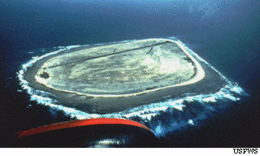
Back Baker-eiland Afrikaans جزيرة بيكر Arabic جزيره بيكر ARZ Beyker adası Azerbaijani بیکر آداسی AZB Bakerinsl BAR Бэйкер Byelorussian Бэйкер BE-X-OLD Бейкър (остров) Bulgarian বেকার দ্বীপ Bengali/Bangla
Nickname: New Nantucket | |
|---|---|
 U.S. Fish and Wildlife Service aerial view of Baker Island | |
| Geography | |
| Location | Pacific Ocean |
| Coordinates | 0°11′45″N 176°28′45″W / 0.19583°N 176.47917°W |
| Area | 2.1 km2 (0.81 sq mi) |
| Length | 1.81 km (1.125 mi) |
| Width | 1.13 km (0.702 mi) |
| Coastline | 4.8 km (2.98 mi) |
| Highest elevation | 8 m (26 ft) |
| Administration | |
| Status | Unincorporated |
| Demographics | |
| Population | 0 |
| Additional information | |
| Time zone |
|
| Designated | 1974 |
Baker Island, formerly known as New Nantucket,[1] is an uninhabited atoll just north of the Equator in the central Pacific Ocean about 3,090 km (1,920 mi) southwest of Honolulu. The island lies almost halfway between Hawaii and Australia. Its nearest neighbor is Howland Island, 42 mi (68 km) to the north-northwest; both have been claimed as territories of the United States since 1857, though the United Kingdom considered them part of the British Empire between 1897 and 1936.
The island covers 2.1 km2 (0.81 sq mi),[2] with 4.8 km (3.0 mi) of coastline.[2] The climate is equatorial, with 80°F Temperature, scant rainfall, constant wind, and strong sunshine. The terrain is low-lying and sandy: a coral island surrounded by a narrow fringing reef with a depressed central area devoid of a lagoon with its highest point being 8 m (26 ft) above sea level.[2]
The island now forms the Baker Island National Wildlife Refuge and is an unincorporated and unorganized territory of the U.S. which vouches for its defense. It is visited annually by the U.S. Fish and Wildlife Service. For statistical purposes, Baker is grouped with the United States Minor Outlying Islands. Baker Island and Howland Island are also the last pieces of land that experience the New Year (furthest behind time zone – UTC−12:00). Baker Island is one of the most remote U.S. equatorial possessions.[3]
- ^ Rauzon, Mark J. (2016). Isles of Amnesia: The History, Geography, and Restoration of America's Forgotten Pacific Islands. University of Hawai'i Press, Latitude 20. Page 110. ISBN 9780824846794.
- ^ a b c "United States Pacific Island Wildlife Refuges". The World Factbook (2024 ed.). Central Intelligence Agency. Retrieved April 25, 2014. (Archived 2014 edition.)
- ^ Rauzon, Mark J. (2016). Isles of Amnesia: The History, Geography, and Restoration of America's Forgotten Pacific Islands. University of Hawai'i Press, Latitude 20. Pages 38 and 104. ISBN 9780824846794.
© MMXXIII Rich X Search. We shall prevail. All rights reserved. Rich X Search
